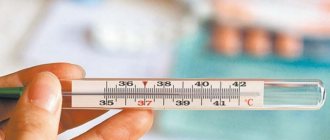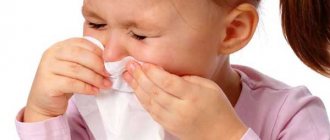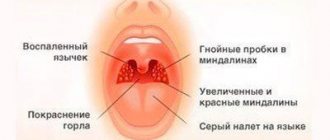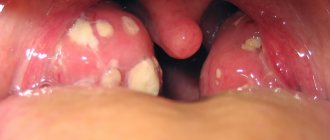When signs of illness appear, you need to understand how long a child’s temperature can last with ARVI. This symptom manifests itself differently in everyone. Under some conditions, a slight increase in temperature is normal, but its presence over a long period should be cause for concern. You should use the thermometer correctly and pay attention to other signs that may appear as complications develop.
What happens to a baby with ARVI?
The group of diseases united by the designation ARVI includes viral infections, including influenza. Most often, symptoms appear in the winter, in the off-season. When the temperature is unstable, the body is exposed to temperature changes and sudden gusts of wind. High air humidity and precipitation also affect health. These factors contribute to the creation of conditions under which the risk of developing viral infection in children increases.
Normally, a child’s body temperature is 36…37°C. These values were obtained by installing a thermometer in the armpit. If a virus infection occurs, the temperature increases (from 37°C and above). The peculiarity of diseases of this type is that the fever intensifies in the evening. If a different nature of the course of the disease is noted, then the development of a bacterial infection or another pathological process is assumed.
With a viral infection, the child's temperature is 37°C or more. This is one of the first signs, but it appears after the incubation period ends. At this stage, the pathological process occurs without cold symptoms (runny nose, cough, nasal congestion, headache, etc.).
On the contrary, a person often becomes contagious 1 or several days before the first signs of the disease appear. Only after this are the main symptoms of a respiratory viral infection detected. Their intensity increases as the disease progresses, which indicates intensive reproduction of pathogenic particles.
When a child’s cold temperature increases to 37°C, various processes are activated:
- the intensity of virus reproduction decreases, as a result, a child’s symptoms after acute respiratory viral infection may quickly disappear;
- the production of interferon gamma is enhanced, which protects cells from the effects of pathogenic particles;
- The activity of lymphocytes increases, as a result, antimicrobial and antiviral antibodies appear.
Doctor Komarovsky: temperature in a child with ARVI
The popular children's doctor, presenter and author of books on children's health, examines the specifics of the disease ARVI with a detailed description of effective treatment methods. He considers an increase in body temperature, which is accompanied by:
- Intense headache;
- Nausea and vomiting;
- The appearance of a rash;
- Pale skin.
When measuring the child’s body temperature, Dr. Komarovsky E.O. advises calling an ambulance if it reaches 39.5 °C in the armpit, and 40 °C in the area of the auricle, mouth and rectum. Children whose condition does not improve 30 minutes after taking antipyretics also need emergency care for acute respiratory viral infections. Komarovsky E.O. notes that if a child under 3 months has a constant fever, then he needs emergency help and should not resort to self-medication.
He also draws attention to the fact that at the first signs of ARVI, the child needs to:
- Create favorable conditions in the room where the child is. The air temperature should be from 18 oC to 20 oC and air humidity from 50% to 70%. To do this, the doctor recommends that all parents have a thermometer, a hydrometer, a household humidifier and adjustable heating radiators at home.
- Dry clothes. You should not dress your child warmly. He should be dressed in easily removable clothes, for example, pajamas, and covered with a warm blanket (more than one), which the child can take off if necessary. You should not wrap children up, tuck the child’s legs and arms under a blanket, or otherwise try to warm him up.
- The doctor pays special attention to parents on the recommendations of the World Health Organization, which prohibits rubbing the child with various means, for example, vodka or vinegar. The baby's skin is very sensitive and easily absorbs these substances, after which they enter the baby's bloodstream. Also, a child with ARVI should not come into contact with cold water, which prohibits the use of wet rags, which loving parents love to apply to their foreheads on the advice of the older generation.
- The doctor advises starting treatment at the first signs of a cold. He lists the main types of emergency care and treatment.
- Drink plenty of fluids or take oral rehydration agents (ORS), which replace fluid lost in the body. For drinks, you should give preference to dried fruit compote and raisin decoction. If the child refuses to drink it, then, for example, small children can be given a drink from a syringe, applying the liquid to the inner side surface of the cheek.
- Antipyretics in liquid form, which are available without a doctor's prescription and should be in the home medicine cabinet of all parents - paracetamol and ibuprofen. A single dose of paracetamol is 15 mg per 1 kg of child weight, the maximum daily dose is 60 ml/kg. Can be used no more than 4 times a day. A single dose of ibuprofen is 10 mg per 1 kg of child weight, the maximum daily dose is 25-30 mg/kg. Can be used no more than 3 times a day.
Komarovsky E.O. also advises parents not to use mercury thermometers to measure their child’s body temperature. According to one of the programs of the World Health Organization, by 2020, all medical institutions are planning to remove from use all treatment devices containing certain mercury compounds.
In conclusion, it is worth noting that elevated temperature during ARVI in children does not cause them severe pain and does not cause severe complications if they consult a doctor in a timely manner. To preserve the child’s health from viral infections, it is recommended to take a set of preventive measures, such as taking vitamins to maintain a strong and stable immune system.
What temperature occurs during ARVI?
Considering that the norm is an indicator in the range of 36...37°C, its increase to 37.1 and above is considered a consequence of a pathological process. It is impossible to say exactly what temperature occurs during respiratory viral diseases. This is due to the fact that each child’s body reacts differently to the introduction of viral particles into cells. As a result, some children do not have a fever during ARVI, while others, on the contrary, during a cold, the temperature rises to the upper limit.
However, they note the indicators that are recorded most often in children: 37.5...39°C. This is a sign of a simple viral infection. The child has a high fever due to influenza (39.5...40°C). Fever appears in severe cases of the disease, against the background of complications. The heat in this case is a consequence of the body’s attempt to create less suitable conditions for the proliferation of pathogenic particles that are resistant to negative external factors.
It is noted that during a viral infection, the temperature may increase in one child and decrease in another. The intensity of the development of fever depends not only on the type of infection, but also on the condition of the child’s body. Negative factors that influence this: chronic diseases, low immunity, stress, vitamin deficiency, developing inflammatory process of another etiology.
You need to understand how many days a child’s temperature can last with respiratory viral infections. So, in most cases with such diseases, excess heat is released by the body for several days. A longer course of the disease is a sign of the development of complications, secondary infection, and pathological processes. If a child has had a high fever for a long time (more than 7 days), you should consult a doctor, because in this case it is necessary to change the treatment regimen due to a developing bacterial infection or other complications.
Why does it rise
If the temperature lasts a long time during ARVI, you need to understand what is happening in the body. Thus, when viral particles enter, the upper respiratory tract is primarily affected. Viruses penetrate the cells of the ciliated epithelium and contribute to their modification. As a result, accelerated death of the epithelium in the nose occurs. This is one of the reasons why signs characteristic of ARVI appear: swelling of the nasal mucosa, rhinitis, etc.
When the protective layer in the form of ciliated epithelium is destroyed, pathogenic particles can freely penetrate into the blood. In this way, viruses spread throughout the body. At this stage, fever often develops, accompanied by intense heat. At the same time, the patient’s condition worsens and the intensity of symptoms increases. This is a consequence of an increase in the number of pathogenic particles. Possible scenarios for the development of events:
- low-grade fever due to viral infection: 37...38°C;
- febrile: 38…39°C;
- pyretic: 39…41°С;
- hyperpyretic: 41°C and above.
The manifestation of symptoms in each case depends on the type of virus. Temperatures with the influenza virus reach extreme values. The lowest values of this parameter are recorded for parainfluenza and rhinovirus infection. But in these cases there are also exceptions when the child has a high fever for a long time. In this case, the reason explaining why the baby has a fever should be sought in his body (other diseases). In this case, the functioning of the internal organ may be disrupted, and secondary infection may develop.
It is often not difficult to notice the development of such a process, since signs appear that are uncharacteristic of ARVI. If you find out how many days a child’s fever lasts, you can guess what pathological process is developing, because for various diseases, including infectious ones, the incubation period and the phase of development of fever are different.
How long does it last?
The duration of the period during which the body intensively produces heat can vary greatly. But to prevent the development of complications, you need to understand how many days the temperature lasts during ARVI. Thus, with an uncomplicated disease caused by rhinovirus infection, low-grade fever is observed for 5 days. The indicated period varies up and down.
If the temperature is febrile (38°C or higher), it can last 3-4 days with a viral infection, then it begins to decrease. The speed of normalization of health depends on the type of infection, the state of the body, the conditions in which the child is, and compliance with the doctor’s recommendations.
It should be taken into account that an increase in temperature during ARVI in children is the norm, despite the fact that the pathological process develops. This is a natural reaction of the body to the penetration of negative particles. If heat is intensely generated for several days, and there are no uncharacteristic signs, it is enough to use auxiliary treatment means (rinsing the nose, gargling, drinking warm liquid in large volumes, maintaining the temperature in the room).
It depends on how long the child’s fever during ARVI lasts, whether it is necessary to use antipyretic drugs. So, with low-grade symptoms, it is not recommended to interfere with the process using Nurofen, Panadol and the like. In this case, the body will stop fighting the virus on its own, which will lead to an increase in the duration of the course of treatment and the development of complications.
If the temperature lasts for a long time, you need to take into account the nature of its change. Thus, doctors do not recommend eliminating signs of fever if this indicator does not exceed 38.5°C. But it is important to take into account the child’s condition.
For example, if there is no lethargy, the appetite is normal, and the child is physically active and feels well, then the temperature does not drop until it rises to the upper limit of the pyretic range. When children do not tolerate heat well, feel weak, have a headache, then it is necessary to intervene in the treatment process until the temperature rises to 38.5 ° C, because in this case there is a risk of seizures.
It is also impossible to observe the development of a pathological process accompanied by an increase in temperature to the pyretic or hyperpyretic range. In both cases, the threat to the health and life of the child increases. At the same time, they note a significant risk of dehydration - the younger the children are, the more fluid comes out, and it is not always easy to replenish its deficiency without a dropper. In addition, an increase in the load on the heart is noted.
Why doesn't it subside?
When the temperature is maintained for 7 days or longer, and it has a wave-like character (decreases, increases), you need to consult a doctor. The main reason is secondary infection. This is the most common complication among children. You need to understand how many days the temperature lasts for ARVI; if all the deadlines have passed, other reasons are considered. With secondary infection, a bacterial infection develops. In this case, fever is also noted, but in most cases a low-grade temperature is maintained.
It is difficult to independently determine the development of a bacterial infection against the background of a viral infection. The diagnosis must be made by a doctor, since an increase in the febrile period may be a consequence of other pathological conditions. Most often, a series of tests are required to make a diagnosis. This will make sure that a bacterial infection is developing. Other probable reasons for the increase in the febrile period:
- inflammatory reaction;
- exacerbation of chronic diseases of various etiologies;
- temperature tail after ARVI in a child.
The last factor is the least dangerous. The temperature tail is a concept that defines the maintenance of the process of low-intensity heat release by the body after recovery. This is a normal phenomenon and does not have a negative effect on the body. The duration of the period of preservation of the temperature tail can be 10-15 days, several months or six months, which depends on the condition of the patient’s body at the time of treatment of the disease.
In this case, you only need to monitor the child and monitor the emergence of new signs. The fact is that a temperature tail can occur simultaneously with pathological processes, which are also accompanied by a slight increase in temperature. If the child’s condition has changed or warning signs have appeared, you should consult a doctor, since the cause of these symptoms may be the re-development of ARVI. There is a risk of developing other infectious diseases.
The temperature tail appears against the background of other factors:
- suffered stress;
- injury;
- overwork;
- metabolic disorders, adrenal function.
If the temperature persists after ARVI, the following diagnosis is made if the following conditions are met:
- the duration of the period during which the temperature is slightly elevated is 1.5 weeks or more;
- the indicator is within 37...38°C;
- the main parameters when performing a blood test are normal.
How many days can a fever last with ARVI (maximum)?
Answers:
๑♥·Marishka·♥๑
With this course of the disease, the child was prescribed antibiotics correctly. An elevated temperature is a signal that there is an inflammatory process in the body and the body is fighting, over 38 degrees. you should start knocking down with a paracetomol-based children's drug (Nurafen, Calpol). It can last as long as there is inflammation.
You have a viral infection and antibiotics were prescribed for a reason. But it extinguishes not only the virus, but also beneficial bacteria. Therefore, Linex (Acipol or Bifidumbacterin) is needed now for the child.
Genferon is an immunomodulatory drug with an antiviral effect. It will also not be superfluous to restore the child’s health.
Listen to your pediatrician. If in doubt, contact the head of the clinic department, they will check the prescription of medications and provide patronage to the child.
Hello!
Elena Velichko
a week
Rules for taking measurements with different types of thermometers
Methods for determining body temperature may be different, but in each case it is important to choose the area on the body where the skin is most sensitive. Areas where the thermometer should be placed:
- armpit;
- anus;
- oral cavity;
- inguinal fold;
- Auricle.
The first option is more popular because it is universal and can be used to measure temperature in any conditions. If it is important to obtain the most accurate value, the thermometer is placed in the anus. This method is recommended for measuring temperature in children under 3 years of age.
When a child has a high fever, you need to act quickly. You should know in advance how to prepare a thermometer for measurements. The steps may vary depending on the type of device. For example, if you plan to use an electronic thermometer, you just need to turn it on by pressing a button. Then you need to wait until the minimum value is established. If your device does not have such a function, you must configure it yourself.
Preparing a mercury thermometer:
- Before use, check the glass case for damage.
- Rinse the thermometer under cold water, then treat it with an antiseptic.
- If the mercury column is above 36.6°C, it needs to be moved. To do this, shake the thermometer. It is recommended to do this above a sofa or bed to avoid damage to the device if it falls.
Before using any thermometer, you need to treat its narrow part with water-soluble lubricant or Vaseline. This measure will make it easier for the sensitive part of the device to enter the anus. If another measurement method is chosen, it is enough to treat the narrow part of the thermometer with an antiseptic solution.
Features of the axillary measurement method:
- the narrow part of the thermometer should be completely surrounded by skin, the device should be held by pressing your hand to your body;
- Duration of the procedure: 5-10 minutes, because of this, it is difficult for children in the first years of life to measure their temperature, because in most cases they cannot stay in one place for a long time;
- This method is inferior in accuracy to the anal method (the difference is up to 1°C).
Recommendations for performing the rectal measurement method:
- An oral thermometer cannot be used for this purpose;
- the depth of insertion of the narrow part of the thermometer into the rectum is 2.5 cm;
- Duration of measurement with a mercury device - no more than 3 minutes;
- it is important not to make any movements at this time, especially if you are using a thermometer in a glass case;
- there is no possibility to use this method for stool disorders (diarrhea, diseases of the rectum, for example, acute period of hemorrhoids, sphincter fissures, etc.);
- Before and after performing the temperature measurement procedure, the thermometer is treated with an antiseptic.
Mercury thermometers
The device is a glass tube that is sealed on all sides. There is a reservoir inside that contains mercury. The area where it connects to the capillary tube is somewhat curved; here it narrows. There is also a scale with values up to 42°C. Mercury in a medical thermometer upon contact with a heat source (the human body) begins to rise through the capillary tube. After cooling, the column remains at the same level.
If the housing is damaged, mercury is released and can cause harm to humans. This is the main drawback of such a device. Recommendations for measuring temperature:
- before installing the thermometer in the armpit, you should make sure that the mercury column has reached 35...36 ° C;
- when the thermometer is shaken to reduce the temperature, it is necessary to hold it so that the index finger is at the end of the sensitive part;
- the reservoir with mercury should be at the bottom during shaking;
- make several quick identical movements with the hand, while it bends at the elbow joint, each time sharply falling down.
Digital Thermometer
It runs on batteries, and when the charge capacity of the power source decreases, the instrument's error increases. Its service life depends on the intensity of use. In this case, the determining factor is the load placed on the power source. Under normal conditions, the error in temperature measurement is 0.1-0.3°C (sometimes more). This means that both types of devices are not inferior to each other in terms of accuracy.
Like a mercury thermometer, an electronic thermometer should fit snugly against the skin in the armpit. Only in this case the measurement error will be minimal. Manufacturers of such devices claim that electronic devices of this type work faster than mercury ones: 10 seconds are enough for measurements (the maximum value is 1 minute). However, in practice it turns out that to obtain a more accurate value you need to hold the thermometer for at least 5 minutes.
The battery-powered thermometer detects the highest temperature over the elapsed period (5 minutes), but gives an average value. The temperature of the human body is constantly changing (the difference can be 1°C). This is the main reason why you should keep the thermometer in your armpit for 5 minutes. By comparison, the mercury analogue works slightly differently: it determines the maximum temperature during the elapsed period.
Electronic devices are best used for anal or oral measurements. However, this option is not popular in Russia. To facilitate the temperature measurement procedure, an on/off button is provided.
Infrared thermometer
When using such a device there is no need for direct contact with it. It is enough to hold the thermometer at some distance from the outer skin of a person. The operating principle of the device is based on the Stefan-Boltzmann law. It makes measurements by determining the relationship between infrared radiation and temperature. The desired result is achieved thanks to the built-in sensor. It captures heat from the human body and calculates the temperature.
The error of a non-contact (infrared) thermometer is higher than that of the considered analogs and is 0.3-0.5°C. Recommendations for using such a device:
- there should be no drafts in the room; the fan heater and air conditioner will distort the measurement result;
- the outer coverings in the area where the device will be directed must be clean and dry;
- the device must be cleaned of dust (wipe the sensor with a dry cloth);
- The thermometer is pointed at the forehead, the recommended distance to the skin is 4-6 cm.
The duration of measurements is no more than 2 seconds.
Disposable strips
This is a simple but not effective method. It is based on the use of small strips. They are fixed on the forehead using an adhesive substance contained on the underside. The disposable strips contain crystals that react to a heat source. As a result, they change color. At home, such devices are rarely used. They are designed for traveling when it is not possible to take a large number of large items.
Normal body temperature in children.
The body temperature of a healthy child in the armpit is about 36–37 °C1. In the rectum it is 0.5 or 1 unit more1. At different ages, children's temperature reacts differently to ailments such as tonsillitis, bronchitis, flu and other diseases. As we grow older, our ability to transfer or retain heat changes. For example, in newborns with minor pathologies, body temperature can change several times a day1. In most cases, such short-term changes are associated with infectious infection1. With such jumps, identifying and monitoring the progress of the disease is much more difficult. If a child has a temperature significantly higher than normal for 6 or more days, then drastic measures should be taken.
Alarming symptoms during a fever
When studying information about how many days the temperature can stay at 37...39°C, you need to find out what consequences arise. This will make it possible to quickly determine their development during treatment of acute respiratory viral infections or during the recovery stage, when the temperature tail still appears. Alarming symptoms:
- the temperature increases intermittently (several days);
- cold symptoms persist longer than 7 days;
- problems with the gastrointestinal tract appeared, for example, vomiting;
- Strong headache;
- photosensitivity;
- respiratory dysfunction;
- pain in the bridge of the nose, eyes, nose;
- dry cough.
Considering that some of these symptoms are dangerous to health and life, it is important to understand how long a high temperature can remain at the same level. This will help distinguish fever from other diseases.
Duration of fever
Adults can maintain a high temperature without much harm to health (with acceptable values) for up to 2-3 days. An elevated temperature in a child with ARVI can last up to 5 days, this is due to the characteristics of children's immunity.
There are times when the fever does not go away, and parents begin to panic about the baby’s well-being. Such situations happen if:
- The child “caught” the adenovirus. How long the temperature lasts during acute respiratory infections in this case depends on the activity of the immune system, but the baby may suffer from fever symptoms for a whole week.
- The rise in temperature in children with parainfluenza can be even longer - up to two weeks, and its maximum values are observed on days 4-5. A high temperature with respiratory syncytial infection lasts approximately the same amount of time.
The answer to the question of how many days the temperature lasts during ARVI also depends on whether a bacterial infection has been added to the viral infection. In this case, complications may arise, which, in turn, provoke a continuation of the febrile state. Most often develop:
- sore throats with tonsil lesions,
- pneumonia with spread of the disease to the lungs,
- sinusitis with damage to the nasal sinuses,
- otitis with infection in different parts of the hearing organ,
- the most serious complications affect the brain, heart muscle, urinary system, and respiratory organs (meningitis, myocarditis, pyelonephritis, stenotic bronchitis).
How to act correctly
If the disease lasts a long time, the temperature during ARVI does not decrease, the main task is to determine the moment when it is necessary to bring it down. The borderline value is 38.5°C. If the child does not have a tendency to convulsions (this symptom in most cases occurs when the temperature rises to 37.5 ... 38 ° C), no action is taken to eliminate the fever. You just need to strive to alleviate the child’s condition: you can wipe the skin with water at room temperature, give a lot of liquid (water, compote, tea).
The doctor prescribes symptomatic treatment (to eliminate signs of rhinitis, sore throat, etc.). When there is a need to reduce body temperature, the following drugs are used: Nurofen, Panadol, Analdim, Efferalgan, Ibufen. If the temperature does not go down, alternate medications based on paracetamol and ibuprofen, taking a break (several hours). The dosage of both types of medicine is calculated by the doctor based on the child’s body weight.
Treatment of ARVI in children
How to treat this disease? Most often, a specialist prescribes complex therapy, which includes the following measures:
- Bed rest. The baby should spend the entire treatment period in a horizontal position. After all, he has excessive weakness. Therefore, you should rest as much as possible.
- Use of antiviral drugs.
- Relief of unpleasant symptoms. If a child has a runny nose and nasal congestion, then vasoconstrictor drops are used, such as Nazol, Nazivin, Pinosol, etc. As for cough, children can use syrups: Doctor Mom, Gerbion, Flavamed, as well as their analogues.
Antiviral drugs should be discussed in more detail. After all, depending on the severity of the disease, the following drugs are used for ARVI:
- Anti-inflammatory non-steroidal drugs. Used at temperatures 38C and above. These medications are aimed at relieving symptoms, as well as inflammatory processes in the body. The most effective are: Ibuprofen, Paracetamol, as well as their analogues.
- The use of drugs that reduce sensitivity to pathogenic viruses. Examples of such drugs: Cycloferon, Amiksin, etc.
- Antihistamines. Helps relieve swelling of the nasopharynx and also relieves pain. For these purposes, the following drugs are used: Claritin, Fenistil, Fenkarol, etc.
- Antibiotics. Prescribed for severe forms of ARVI, as well as for complications of this disease. How long does the temperature last when taking antibiotics? On average, this symptom goes away within 7 days.
- Taking vitamins. They help boost immunity, making the child’s body more actively fight the virus. Eating seasonal vegetables and fruits raw will be beneficial.
Important to remember! During the treatment period, you should strictly adhere to the dosage prescribed by the doctor! If your baby experiences a deterioration in health even after taking medications, you need to consult a doctor. He will make adjustments to the treatment regimen.
Degrees of temperature rise
During an acute respiratory infection, an increase in temperature in a child is a normal phenomenon, which indicates that the body is fighting a viral infection. There is no need to be afraid of this process, even if it occurs in a baby.
At the same time, experts distinguish several degrees of high temperature during acute respiratory infections and other diseases:
- Subfebrile. In this case, the thermometer mark does not exceed 37-38 degrees.
- Febrile. The temperature can be between 38-39 degrees.
- Pyretic. The thermometer readings reach 39-41 degrees.
- Hyperpyretic. The child has a high fever, and the body temperature rises to more than 41 degrees. When this level is reached, the active breakdown of proteins begins in the body, which can lead to dire consequences. Self-medication in this case is dangerous not only for the child’s health, but also for his life. Therefore, it is better to entrust the issue to professionals.
By the way, there is such a thing as low temperature. In most cases, this phenomenon occurs after the end of the disease or as a result of overwork. In medical practice, in this case, the term “loss of strength” is often used.
When are antipyretics needed?
The effect of high temperatures is fatal to viruses and bacteria. When exposed to them, they are not capable of reproduction, their activity becomes slow. Against this background, their death occurs. Therefore, do not rush to immediately lower your temperature during ARVI.
It is recommended to take antipyretic medications when the patient himself cannot tolerate the effects of high temperatures: joint pain, headaches, problems with the functioning of the brain and heart. In this case, it is enough not to bring the indicators to the established norm, but simply to bring them down a little. Your health will improve, and your body will continue to fight viruses and bacteria.
Children are more sensitive to the effects of temperature, so in order to avoid heat cramps, readings that reach 38-39 degrees should be reduced. If you cannot do this on your own, you should call an ambulance. An antipyretic is required to be given to a child if:
- Temperature 39, accompanied by pain in the head and muscles.
- Temperature of 38.5, developing against the background of existing serious diseases of the lungs or heart.
- Temperature 38-38.5, if heat cramps occur.
In adults, exceeding the temperature threshold of 39.5 degrees can cause serious problems with the functioning of the nervous system. For patients under 15 years of age, the use of Aspirin or Analgin to relieve fever is contraindicated. To bring down the temperature, children can be given:
- Paracetamol
- Ibuprofen
If the body tolerates a temperature of 37-38 degrees well, then it is advisable not to bring it down. If it does not go away for more than 5 days, then you should consult a doctor.
When taking antipyretic medications, both adults and children should adhere to the dosage and duration of treatment indicated in the instructions for use. After ARVI, a so-called “temperature tail” may be observed. This is a condition in which a person, after recovery, may maintain an elevated body temperature (37-37.8 degrees), called subfebrile, for some time. This shouldn't be scary.
For complete reassurance, take additional blood and urine tests. If a viral or bacterial infection continues to develop, this will certainly affect indicators, for example, of leukocytes or ESR.
Temperature chart
Taking antipyretics
So, based on all of the above, we can draw a conclusion about what temperature needs to be lowered. For children it is 38-38.5 degrees. For a child under one year old, in some cases it is allowed to reduce the fever with the help of medications when it reaches 37.5 degrees. But this is only in cases where the baby has become capricious, refuses to eat, or has convulsions.
How often it is necessary to take antipyretics depends on the characteristics of the child’s body. At the same time, you do not need to set yourself the goal of reducing the temperature to 36.6. In most cases this is impossible to do. With acute respiratory infections, it is enough to simply reduce it to 37.5 degrees.
It is best to reduce the temperature in children under one year of age and older with the help of ibuprofen-based syrups. An example of such a drug would be the well-known Nurofen. Paracetamol-based suppositories also do an excellent job. But “adult” drugs in the form of tablets (Aspirin and others) are strictly contraindicated for children.
Causes of fever during ARVI
One of the symptoms of an acute form of a viral respiratory infection can confidently be called an increase in temperature. This is exactly what the body’s defensive reaction looks like when it tries to resist the activity of a virus that has entered it.
Usually, with ARVI, the temperature stays within 37 degrees. This is enough to fight the virus. For humans, this indicator does not pose a danger. She should not be “treated.” In the normal course of the disease, such fever goes away on its own after 3-5 days.
In exceptional situations, the temperature can increase further and reach 38 or even 39 degrees. This is especially common in children and infants. Their immunity has not yet fully matured and thus reacts to the virus. The temperature indicator depends on several factors:
- Patient's age
- The strength of his immune system
- Type of viral infection strain
During acute respiratory viral infections, temperature has a positive effect on the body. Fever triggers the body to produce antibodies that can absorb viral cells. Maximum production of the antiviral substance is achieved at levels of 38.5.
Temperature reduces the activity of pathogenic bacteria and enhances the antitoxic effect. It follows that the higher the temperature, the stronger the toxic effect of the virus on the body.
The positive effect on the body concerns only temperature indicators that do not exceed 39 degrees. Such indicators are always associated with headaches, disruption of the functioning of some internal organs (heart, liver) and brain. Prolonged fever can cause dehydration. This is also why drinking plenty of fluids is recommended during ARVI.
Dr. Komarovsky about the reasons for the rise in temperature:










